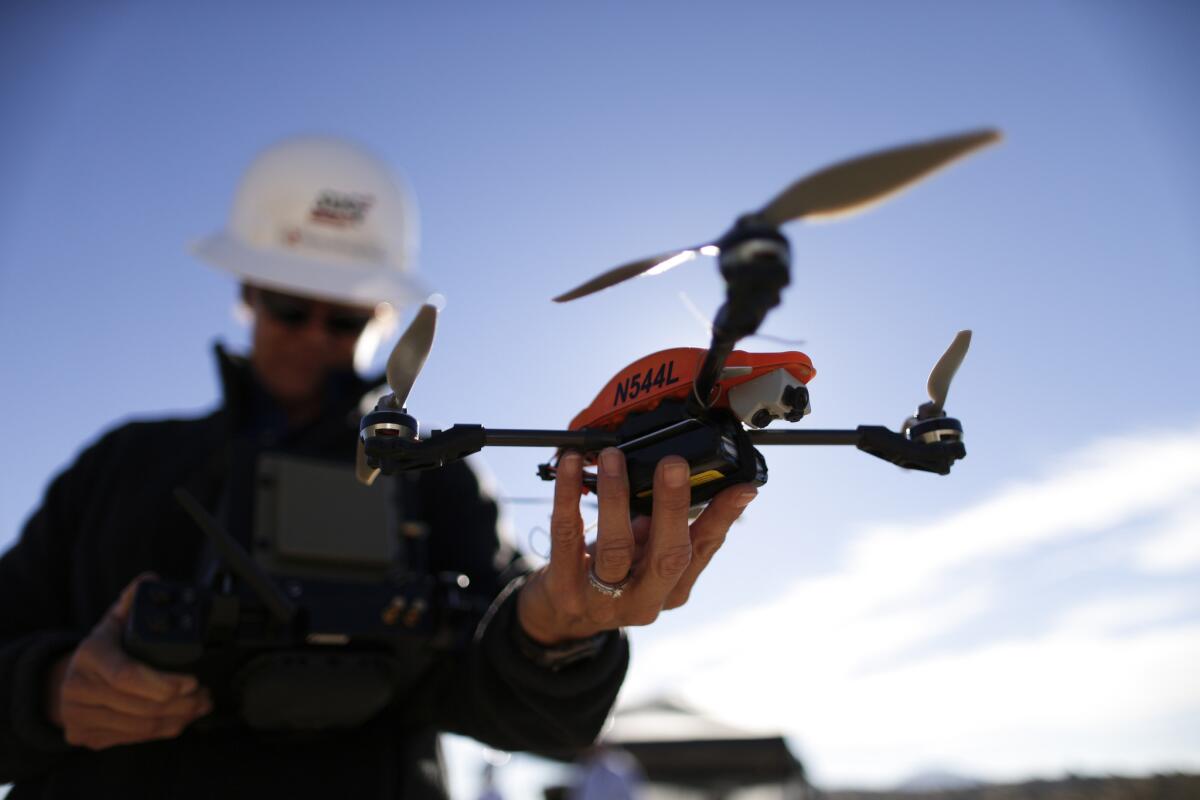Proposed FAA rules would limit commercial drone use

- Share via
Reporting from Washington — Federal officials unveiled proposed rules Sunday for the operation of small commercial drones, potentially opening the skies to greater use of unmanned aircraft to perform tasks such as inspecting bridges, assisting in search-and-rescue operations, taking aerial photos of real estate and shooting scenes for movies and television.
In announcing the proposal, Federal Aviation Administration chief Michael Huerta said he expected commercial drones would “dramatically change the way we use our nation’s airspace.”
Notably, though, the proposed rules would prohibit paid package delivery, as both Amazon and Google have experimented with, and dropping objects from drones. They also would require that a drone remain in sight of its operator.
Amazon has trumpeted its Prime Air project, which seeks to one day get deliveries into customers’ hands in 30 minutes through use of small, unmanned aerial vehicles. The proposed rules leave out Prime Air, said Paul Misener, Amazon’s vice president for global public policy. He called on the government to issue guidelines for package delivery by drone as well.
“The FAA needs to begin and expeditiously complete the formal process to address the needs of our business, and ultimately our customers,” he said in a statement. “We are committed to realizing our vision for Prime Air and are prepared to deploy where we have the regulatory support we need.”
Officials said the rules, which apply to drones that weigh 55 pounds or less, were intended to minimize the risk to other aircraft and people and property on the ground. The flights would be limited to daylight hours, to speeds of 100 mph and to altitudes of 500 feet in an effort to keep drones away from higher-flying manned aircraft such as commercial flights, Huerta said in a conference call with reporters.
Drones would not be permitted to fly over people, except those directly involved with the flight. Nor could they be flown near airports, or in restricted airspace without permission, Huerta said.
He said drones would in some cases be able to perform tasks without putting lives at risk, as when manned aircraft is forced to fly over dangerous terrain or in bad weather.
“Safety is always our No. 1 priority,” he said.
The FAA authorized testing of drones at six sites around the country in December 2013 and is working to integrate drones in the national airspace. The newly proposed rules are subject to a 60-day public comment period and won’t go into effect until those submissions are analyzed, which could take years — meaning the drone rules could be implemented after President Obama leaves office in 2017.
Separately, the White House announced Sunday that it was requiring government agencies for the first time to tell the public where they are flying drones and how often, and what information they collect. Those requirements took effect immediately.
Last month, a small drone crashed into the White House lawn, prompting a lockdown. The president was out of the country at the time.
Huerta described a host of tasks that drones in the private sector could perform, including inspecting utility towers, antennas, power lines and pipelines, especially in hilly or mountainous terrain, and monitoring crops, supporting wildlife conservation and assisting news organizations.
Transportation Secretary Anthony Foxx, whose department oversees the FAA, applauded the proposed new rules. “Technology is advancing at an unprecedented pace and this milestone allows federal regulations and the use of our national airspace to evolve to safely accommodate innovation,” he said in a statement.
Republican Sen. John Hoeven of North Dakota called on the Obama administration to work on guidelines for broader commercial use, saying that the demand and the technology have both arrived.
“Today’s proposed regulations are a start, but they have a ways to go before we will be able to apply this new and innovative technology in the realm of commerce,” he said in a statement. “The administration still needs to outline an actual strategy for integration that does the research required for the [drone] industry to reach its full potential.”
Sen. Charles E. Schumer of New York, a top-ranking Democrat, cautioned that the proposed guidelines were merely a start.
“These FAA rules are a solid first step but need a lot more refining,” he said in a statement.
The proposed rules also call for drone operators to be at least 17 and pass a test every two years in order to be certified by the FAA. They would not, however, need a private pilot’s license or be required to undergo medical testing, as pilots do.
Huerta said there would be no limit to the number of flights that could be conducted in a day.
The rules would not apply to model aircraft, which officials said had their own set of rules. The FAA also is considering whether it should create separate rules for unmanned aerial systems weighing less than 4.4 pounds, Huerta said.
An industry group, the Assn. for Unmanned Vehicle Systems International, welcomed the proposed rules but said they were “long overdue.”
Technology “has largely remained grounded while many prospective users wait for the regulatory framework to catch up,” said Brian Wynne, president and chief executive of the nonprofit, which advocates for unmanned systems and robots.
The Arlington, Va., group said it had more than 7,500 members who worked in the defense, civil and commercial markets.
Twitter: @KatherineSkiba
More to Read
Sign up for Essential California
The most important California stories and recommendations in your inbox every morning.
You may occasionally receive promotional content from the Los Angeles Times.













